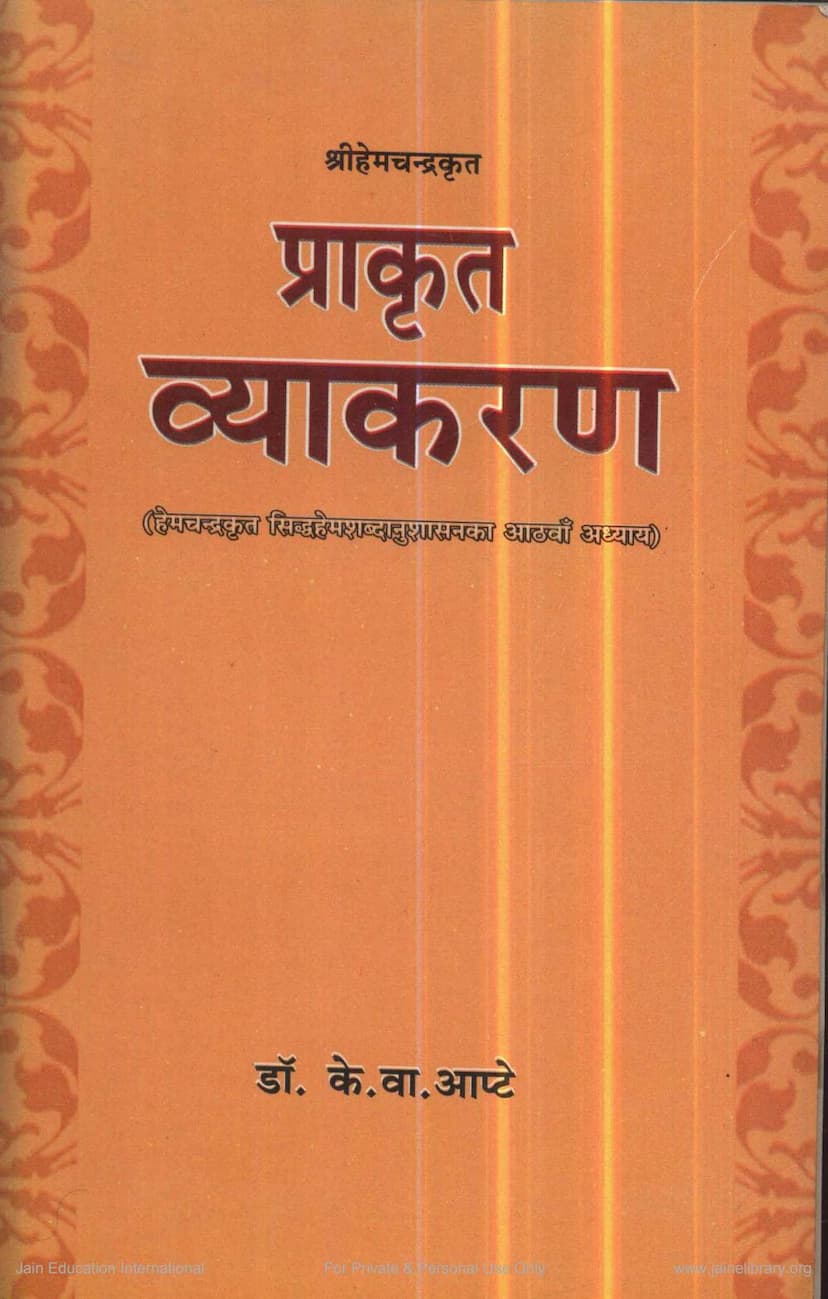Prakrit Vyakarana
Added to library: September 2, 2025

Summary
Prakrit Vyakarana by Hemchandracharya (8th Chapter of Siddha Hema Shabdanushasanam) - Summary
This extensive Jain text, "Prakrit Vyakarana," compiled by Hemchandracharya and edited by Dr. K. V. Apte, serves as the eighth chapter of his larger work, "Siddha Hema Shabdanushasanam." Published by Chaukhambha Vidyabhavan, it meticulously details the grammar of Prakrit, particularly the Maharashtri Prakrit, with references to other Prakrit dialects like Sauraseni, Magadhi, Paishachi, and Apabhramsha.
The book is structured into four Padas (sections), each covering specific aspects of Prakrit grammar.
Overall Structure:
The text provides the original Sanskrit sutras, a Sanskrit commentary (vritti), and a Hindi translation with extensive notes. It aims to offer a comprehensive understanding of Prakrit grammar, making it accessible to a wider audience for the first time with a Hindi translation.
Key Areas Covered in Each Pada:
First Pada (प्रथम पाद): This section focuses on the foundational aspects of Prakrit grammar, including:
- Introduction to Prakrit: Defining Prakrit and its relationship with Sanskrit, exploring the etymology and different interpretations of the word "Prakrit."
- Vowel Changes: Detailed rules regarding vowel lengthening and shortening, especially in compound words.
- Sandhi (Phonetic Combination): Rules for the combination of vowels and consonants, noting differences from Sanskrit and the concept of "vyavasthitavibhasha" (context-dependent optionality).
- Special Rules: Changes related to specific sounds like i and u before vowels, e and o before vowels, and the behavior of vowels when consonants are elided (udvritta).
- Consonant Changes: Rules pertaining to the modification and elision of final consonants in words and their behavior in compounds.
- Gender and Case: Discussions on gender agreement and the usage of case endings.
- Specific Word Modifications: Rules for changes in words like nir, prati, and antar.
Second Pada (द्वितीय पाद): This pada delves deeper into more complex grammatical structures and changes:
- Consonant Clusters: Rules governing changes in conjunct consonants.
- Sound Changes and Replacements: Modifications and replacements of certain sounds in specific contexts.
- Word Formation: Rules for deriving new words, including the use of various suffixes and their modifications.
- Nouns and Pronouns: Detailed declension patterns, usage of pronouns, and their various forms.
- Numerals and Indeclinables: The forms and usage of numerical words and indeclinable words (avyaya).
Third Pada (तृतीय पाद): This section focuses on morphology and the formation of words and sentences:
- Verb Conjugations: Rules for verb forms in different tenses (present, past, future), moods (imperative, potential), and voices (passive).
- Tenses and Moods: Specific conjugations for common verbs like as (to be).
- Derivational Suffixes: Rules for applying various suffixes to form different types of words (e.g., verbal nouns, adjectives).
- Pronoun Declension: Detailed declension of personal pronouns (yushmad, asmad) and demonstrative pronouns.
- Numerical Words: Declension of numerical words.
- Usage of Cases: Rules for the application of different case endings in sentences.
- Noun-Verbs (Namdhatus): Formation and conjugation of verbs derived from nouns.
Fourth Pada (चतुर्थ पाद): This final section covers a broad range of topics, including advanced verb morphology, dialects, and exceptions:
- Verb Derivations: Rules for causative verbs, further modifications of verb roots, and specific changes before certain suffixes.
- Specific Dialects: Detailed analysis of the grammatical features of various Prakrit dialects including:
- Shauraseni: Characteristics and examples.
- Magadhi: Characteristics and examples.
- Paishachi: Characteristics and examples, including Chulika Paishachi.
- Apabhramsha: Characteristics and examples, highlighting its development and variations.
- Deviations from Prakrit: Rules related to deviations and exceptions in Prakrit grammar.
- Concluding Remarks: A summary of the Prakrit grammatical features discussed.
Significance of the Work: Hemchandracharya's "Prakrit Vyakarana" is considered a foundational text for understanding Prakrit languages. Its detailed grammatical rules, comprehensive examples, and its placement within the larger "Siddha Hema Shabdanushasanam" make it an invaluable resource for scholars and students of Indo-Aryan languages, linguistics, and Jainology. Dr. K. V. Apte's edition with Hindi translation further enhances its utility by providing access to this complex subject matter in an accessible language. The introduction also provides a historical and linguistic context for Prakrit within the broader spectrum of Indian languages.